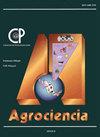益生元、枯草芽孢杆菌和亚磷酸钾对MÉNDEZ鳄梨炭疽病严重程度和采后品质的影响
IF 0.5
4区 农林科学
Q4 AGRICULTURE, MULTIDISCIPLINARY
引用次数: 0
摘要
在牛油果生产过程中,影响牛油果质量和安全的因素主要有农艺管理和气候等。本研究的目的是评价叶面处理对墨西哥Michoacán的Ziracuaretiro和Salvador Escalante两个“mvendez”鳄梨种植区采收后炭疽病(Colletotrichum spp.)防治的影响。采用叶面喷雾剂进行以下处理:1)根据技术人员经验进行常规管理;2)综合管理(IM),包括枯草芽孢杆菌、益生元(BioKakimu®)和亚磷酸钾;3)绝对控制,无需叶面喷洒。考虑到采后炭疽病的严重程度和果品品质,评价了不同处理对生理成熟期果实收获的影响。在评价期内,3种处理对果实表面的病害损害均小于10%。然而,IM处理使ZI和SE的成熟时间分别延迟了12.4天和10.6天。在进食成熟时,IM处理的果实在ZI组(7.6%)比SE组(8.48%)减轻了更少的重量。IM处理和对照处理的果实硬度高于ZI处理,而SE处理的果实硬度无显著差异。ZI和SE处理的果实颜色指数呈下降趋势。鉴于第一次炭疽病警报是在果实收获时发出的,因此得出的结论是,“msamundez”中的植物致病真菌没有长时间暴露在有利于其生长的天气条件下。作物管理方法没有导致果实中果皮养分浓度的增加。本文章由计算机程序翻译,如有差异,请以英文原文为准。
PREBIOTIC, Bacillus subtilis AND POTASSIUM PHOSPHITE ON ANTHRACNOSIS SEVERITY AND POST HARVEST QUALITY IN ‘MÉNDEZ’ AVOCADO
Several factors affect the quality and safety of avocado (Persea americana Mill.) fruit during the production process, such as the agronomic management and climate. The objective of this research was to evaluate how foliar treatments affected postharvest control of anthracnose (Colletotrichum spp.) in two ‘Méndez’ avocado growing areas, Ziracuaretiro (ZI) and Salvador Escalante (SE), Michoacán, Mexico. Foliar sprays were used in the following treatments: 1) conventional management (CM) based on the technician’s experience; 2) integrated management (IM) including Bacillus subtilis, a prebiotic (BioKakimu®), and potassium phosphite; and 3) absolute control without foliar sprays. The effects of the treatments were evaluated on fruit harvested at physiological maturity while taking into account the severity of post-harvest anthracnose and fruit quality up to consumption maturity. During the evaluation period, disease damage was less than 10 % of the fruit surface in all three treatments. However, IM treatment delayed maturation time by 12.4 days in ZI and 10.6 days in SE. Fruits of the IM treatment lost less weight in ZI (7.6 %) than in SE (8.48 %) at eating maturity. Fruit firmness in ZI was higher in the IM and control treatments, while there were no differences in SE. The fruits in ZI and SE showed a decreasing color index profile for the three treatments. It is concluded that the phytopathogenic fungus in ‘Méndez’ was not exposed to weather conditions favorable for its development for an extended period of time, given that the first anthracnose alerts were emitted when the fruits were harvested. The crop management method did not result in an increase in the nutrient concentration of the fruit mesocarp.
求助全文
通过发布文献求助,成功后即可免费获取论文全文。
去求助
来源期刊

Agrociencia
农林科学-农业综合
CiteScore
0.50
自引率
33.30%
发文量
51
审稿时长
18-36 weeks
期刊介绍:
AGROCIENCIA is a scientific journal created and sponsored by the Colegio de Postgraduados. Its main objective is the publication and diffusion of agricultural, animal and forestry sciences research results from mexican and foreign scientists. All contributions are peer reviewed. Starting in the year 2000, AGROCIENCIA became a bimonthly and fully bilingual journal (Spanish and English versions in the same issue). Since 2007 appears every month and a half (eight issues per year). In addition to the printed issues, the full content is available in electronic format.
 求助内容:
求助内容: 应助结果提醒方式:
应助结果提醒方式:


